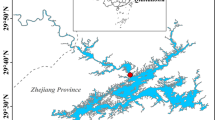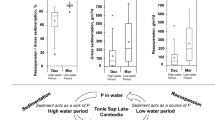Abstract
In general, lakes provide various ecosystem services that support biotic habitats and human life. Lake Toba, the largest caldera volcanic lake in the world, has been functioning as a tourism destination and for fish farming, a fresh water source, and for power supplies. The lake has maximum depth of about 505 m. Stratification in the lake water column especially in a tropical region like Indonesia is a common phenomenon. Stratification of the lake is one important factor which will influence the next stage in the biological processes and water quality of the lake. The objective of the current study was to analyze and elucidate the stratification of Lake Toba through the variations of physical, chemical, and isotopic parameters. Water temperature, dissolved oxygen concentrations, water chemical contents, and isotopic parameters were observed periodically from 2016 until 2019. Fourteen sampling points evenly distributed across the surface of the lake were predetermined to represent the North, South, East, and West of the lake. A conductivity, temperature, and depth (CTD) device and Baro-divers were used to measure temperature and conductivity at various depths in the water column for each sampling point. The water samples for isotopic and chemical parameter measurements were collected from water depths of 0, 20, 40, 60, 80, and 100 m using a horizontal transparent acrylic water sampler at each sampling point. Some results from isotope analysis showed that all the water at all levels along the water column had undergone evaporation. Although there were some slight fluctuations, the chemical composition of the lake water was relatively homogenous up to 100 m of depth. The chemical pattern suggested that there was no other secondary process that altered the chemical composition of the lake water, thus the lake water and river water had the same facies. The stratification of Lake Toba was found to be permanent. The depth of the hypolimnion layer was consistently at about 80 m below the surface. However, the depth of the upper layer, the epilimnion, was strongly affected by the climate at the surface of the lake.










Similar content being viewed by others
Data availability
The datasets generated during and/or analyzed during the current study are not publicly available but are available from the corresponding author on reasonable request.
References
Acreman, M. C., Meigh, J. R., & Sene, K. J. (1993). Modelling the decline in water level of Lake Toba, Indonesia. Advances in Water Resources, 16, 207–222.
Boehrer, B., & Schultze, M. (2008). Stratification of lakes. Reviews of Geophysics, 46, 1–27. https://doi.org/10.1029/2006RG000210.1.INTRODUCTION
Boehrer, B., von Rohden, C., & Schultze, M. (2017). Physical features of meromictic lakes: stratification and circulation. In R. Gulati, E. Zadereev, & A. Degermendzhi (Eds.), Ecology of Meromictic Lakes. Ecological Studies. Springer. https://doi.org/10.1007/978-3-319-49143-1
Chesner, C. A. (2012). The Toba Caldera Complex. Quaternary International, 258, 5–18. https://doi.org/10.1016/j.quaint.2011.09.025
Cooke, G. D., Welch, E. B., Peterson, S. A., & Nichols, S. A. (2005). Restoration and management of lakes and reservoirs (3rd ed.). CRC / Taylor & Francis.
Goodspeed, R., Riseng, C., Wehrly, K., Yin, W., Mason, L., & Schoenfeldt, B. (2016). Applying design thinking methods to ecosystem management tools : creating the Great Lakes Aquatic Habitat Explorer. Mar. Policy, 69, 134–145. https://doi.org/10.1016/j.marpol.2016.04.017
Gopal, B., Ghosh, D., & Delhi, N. (2009). Lakes and reservoirs of Asia. In Reference Module in Earth Sciences and Environmental Systems. Waters.
Guler, C., Thyne, G. D., McCray, J. E., & Turner, A. K. (2002). Evaluation of graphical and multivariate statistical methods for classification of water chemistry data. Hydrogeology Journal, 10, 455–474. https://doi.org/10.1007/s10040-002-0196-6
Horton, T. W., Defliese, W. F., Tripati, A. K., & Oze, C. (2016). Evaporation induced 18O and 13C enrichment in lake systems: a global perspective on hydrologic balance effects. Quaternary Science Reviews, 131, 365–379.
Huser, B. J., Futter, M., Lee, J. T., & Perniel, M. (2016). In-lake measures for phosphorus control : the most feasible and cost- effective solution for long-term management of water quality in urban lakes. Water Research, 97, 142–152. https://doi.org/10.1016/j.watres.2015.07.036
Irham, M., Nasution, T., Muhamad, S., Awal, S., & Permana, D. M. (2016). The methods of preventing water hyacinth as aquatic pollution in Lake Toba caused by agricultural waste. International Journal of Environmental Science and Technology, 7, 630–633. https://doi.org/10.18178/ijesd.2016.7.8.852
Irwandi, H., Syamsu Rosid, M., Mart, T., 2019. Identification of the El Niño effect on Lake Toba’s water level variation. IOP Conference Series: Earth and Environmental Science 406. https://doi.org/10.1088/1755-1315/406/1/012022 1. IOP Publishing
Labaj, A. L., Michelutti, N., & Smol, J. P. (2018). Annual stratification patterns in tropical mountain lakes reflect altered thermal regimes in response to climate change. Fundamental and Applied Limnology, 191, 267–275. https://doi.org/10.1127/fal/2018/1151
Ladwig, R., Hanson, P. C., Dugan, H. A., Carey, C. C., Zhang, Y., Shu, L., Duffy, C. J., & Cobourn, K. M. (2021). Lake thermal structure drives inter-annual variability in summer anoxia dynamics in a eutrophic lake over 37 years. Hydrology and Earth System Sciences, 25, 1009–1032.
Lewis, W. M. J. (1983). Temperature, heat, and mixing in Lake Valencia, Venezuela. Limnology and Oceanography, 28, 273–286.
Lewis, W. M. J. (1973). The thermal regime of Lake Lanao (Philippines) and its theoritical implications for tropical lakes. Limnology and Oceanography, 18, 200–217.
Lukman, H. H., Subehi, L., Dina, R., Mayasari, N., Melati, I., & Sudriani, Y. (2021). Loads of pollution to lake toba and their impacts. International Journal on Advanced Science, Engineering and Information Technology, 11, 930–936. https://doi.org/10.18517/ijaseit.11.3.12733
Lukman, L., Hidayat, H., Subehi, L., Dina, R., Mayasari, N., Melati, I., Sudriani, Y., & Ardianto, D. (2019). Pollution loads and its impact on Lake Toba. IOP Conference Series: Earth and Environmental Science, 299(1), 012051. https://doi.org/10.1088/1755-1315/299/1/012051
Lukman, S. L., & Dina, R. (2020). A preliminary study of stratification in Lake Toba: the largest tropical lake in Southeast Asia. European Modern Studies Journal, 4, 122–131.
Lurling, M., Mackay, E. B., Reitzel, K., & Spears, B. M. (2016). Editorial - acritical perspective on geo-engineering for eutrophication management in lakes. Water research, 97, 1–10. https://doi.org/10.1016/j.watres.2016.03.035
Pal, M., Samal, N. R., Roy, P. K., & Roy, M. B. (2015). Electrical conductivity of lake water as environmental monitoring – a case study of Rudra sagar Lake. IOSR Journal of Environmental Science, Toxicology and Food Technology, 9, 66–71. https://doi.org/10.9790/2402-09316671
Pang, Z., Kong, Y., Li, J., & Tian, J. (2017). An isotopic geoindicator in the hydrological cycle. Procedia Earth and Planetary Science, 17, 534–537.
Piper, A. M. (1944). A graphic procedure in the geochemical interpretation of water analyses. Transactions of the American Geophysical Union, 25, 914–928.
Pujiindiyati, E. R., Sidauruk, P., Prayogi, T. E., & Abdillah, F. (2020). Hydrochemical evolution in Ciliwung River – Java, Indonesia: study of sea water mixture and mineral dissolution. Indonesian Journal of Chemistry, 20, 1360–1373. https://doi.org/10.22146/ijc.50962
Rhodes, J., Hetzenauer, H., Frassl, M. A., Rothhaupt, K., & Rinke, K. (2017). Long-term development of hypolimnetic oxygen depletion rates in the large Lake Constance. Ambio, 46, 554–565. https://doi.org/10.1007/s13280-017-0896-8
Sidauruk, P., Prasetio, R., & Satrio, S. (2020). Applications and development of isotopes hydrology Techniques. Batan Press.
Sidauruk, P., Pratikno, B., & Pujiindiyati, E. R. (2018a). Isotopic characterization of precipitation, inflow, and outflow of Lake Toba as a first assessment of lake water balance study. Atom Indonesia, 44, 1–7.
Sidauruk, P., Pratikno, B., & Pujiindiyati, E. R. (2018b). Isotopic characterization of precipitation, inflow, and outflow of Lake Toba as a first assessment of lake water balance study. Atom, 44, 1–8.
Sihotang, H., Purwanto, M. Y. J., Widiatmaka, W., & Basuni, S. (2012). Model for water conservation of Lake Toba. Journal In Natural Resources, Environmental Management, 2, 65–72. https://doi.org/10.19081/jpsl.2012.2.2.65
Soeprobowati, T. R. (2015). Integrated lake basin management for Save Indonesian Lake Movement. Procedia Environmental Sciences, 23, 368–374. https://doi.org/10.1016/j.proenv.2015.01.053
Suryati, I., Khair, H., Siregar, R. L., Sibagariang, H., & Utami, R. (2021). Study on solid waste generation in Lake Toba area. IOP Conference Series: Materials Science and Engineering, 1041, 012032. https://doi.org/10.1088/1757-899x/1041/1/012032
Tandyrak, R., Grochowska, J. K., Augustyniak, R., & Łopata, M. (2021). Permanent thermal and chemical stratification in a restored urban meromictic lake. Water (Switzerland), 13, 2979. https://doi.org/10.3390/w13212979
Woolway, R. I., Sharma, S., Weyhenmeyer, G. A., Debolskiy, A., Golub, M., Mercado-Bettín, D., Perroud, M., Stepanenko, V., Tan, Z., Grant, L., Ladwig, R., Mesman, J., Moore, T. N., Shatwell, T., Vanderkelen, I., Austin, J. A., DeGasperi, C. L., Dokulil, M., La Fuente, S., et al. (2021). Phenological shifts in lake stratification under climate change. Nature Communications, 12, 1–11. https://doi.org/10.1038/s41467-021-22657-4
Yang, Z., Wu, F., & Gao, X. (2016). Strategy for management of lake-catchment system integrated with natural and anthropogenic factors in China. Physics and Chemistry of the Earth, 96, 26. https://doi.org/10.1016/j.pce.2016.06.006
Yasuoka, Y., & Miyazaki, T. (1982). Remote sensing of water quality in the lake. Journal of The Remote Sensing Society of Japan, 2, 51–62.
Zhao, P., Tang, X., Zhao, P., Wang, C., & Tang, J. (2013). Identifying the water source for subsurface flow with deuterium and oxygen-18 isotopes of soil water collected from tension lysimeters and cores. Journal of Hydrology, 503, 1–10. https://doi.org/10.1016/j.jhydrol.2013.08.033
Acknowledgements
We would like to acknowledge that this study was funded by the Government of Indonesia through BATAN Research Fund (DIPA) of year 2014–2019. I also like to thank our laboratory assistants for providing us the results of stable isotopes and chemical analysis of the samples.
Author information
Authors and Affiliations
Corresponding author
Ethics declarations
Competing interests
The authors declare no competing interests.
Additional information
Publisher’s note
Springer Nature remains neutral with regard to jurisdictional claims in published maps and institutional affiliations.
Rights and permissions
Springer Nature or its licensor (e.g. a society or other partner) holds exclusive rights to this article under a publishing agreement with the author(s) or other rightsholder(s); author self-archiving of the accepted manuscript version of this article is solely governed by the terms of such publishing agreement and applicable law.
About this article
Cite this article
Sidauruk, P., Prasetio, R., Subehi, L. et al. Lake Toba stratification study with physical, chemical, and isotopic parameter approach. Environ Monit Assess 195, 897 (2023). https://doi.org/10.1007/s10661-023-11455-8
Received:
Accepted:
Published:
DOI: https://doi.org/10.1007/s10661-023-11455-8




